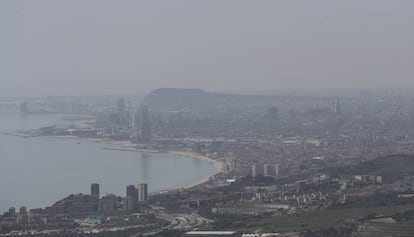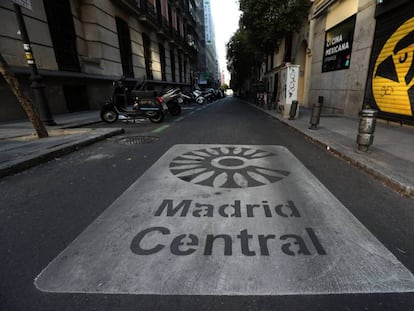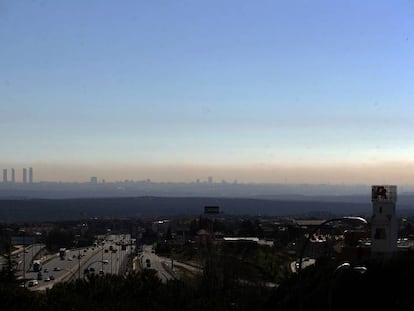Barcelona to cut traffic by 7% next year with a ban on most-polluting vehicles
Following in the footsteps of Madrid, the Catalan capital is planning to restrict the access of vehicles which do not qualify for an environmental sticker from the DGT traffic authority


The Spanish city of Barcelona is preparing to implement restrictions that would, from 2020 onward, prohibit the most-polluting vehicles from entering into its so-called “ZBE” low-emissions zone. This 95-square-kilometer area covers nearly the entire city as well as part of four other municipalities. City Hall calculates that around 50,000 vehicles – including cars, motorcycles and trucks – will cease to circulate in the zone, accounting for 7% of the current total.
Mayor Ada Colau’s team has stated that pollution is “probably the biggest problem” that the city is facing
In line with a similar scheme that was recently introduced in Madrid, only vehicles that have an identifying sticker on their windshield will be allowed in the ZBE. This sticker, issued by Spain’s DGT, classifies vehicles according to their emissions. Older, more polluting vehicles, are ineligible for the badge.
In the medium term, Barcelona council estimates that by 2024, they will have taken 125,000 vehicles out of the center thanks to the activation of the ZBE plan, as well as other schemes such as new cycle lanes, increased public transport options and so-called “superblocks,” areas where only residents will be able to enter. That will see 20% of the current number of vehicles in the Catalan capital removed from circulation, with pollution forecast to fall by 15% as a result.
“This will be a before-and-after moment,” explained Barcelona mayor Ada Colau last week. Her local government estimates that 354 premature deaths a year in the city can be attributed to high pollution levels.
The ZBE was first established in 2017, but this year restrictions will only be enforced in cases of high levels of nitrogen dioxide, a scenario that has yet to occur so far in 2019. But restrictions in the area will come into force permanently in 2020.
These will be applied from Monday to Friday from 7am to 8pm, and will affect all vehicles apart from those in the categories of heavy goods, disabled transport, medical and emergency services, and funeral transports.
City Hall calculates that around 50,000 vehicles will cease to circulate in the zone
From now until the month of September, a debate will be opened as to whether there should be exceptions for the zone and how they should be applied. The plan is to analyze three very specific cases: firstly, people with cars that have no sticker who need to occasionally enter into the city; secondly, whether the restrictions should be lifted on Friday afternoons; and thirdly, whether the rules should be progressively introduced for delivery services or other professionals who need vans for their work but have older vehicles without the environmental sticker.
As in Madrid, vehicles will be monitored via a series of cameras, and offenders will be slapped with €100 fines. The legislation needed to put the system in place has not yet been agreed, and there is not time for it to be finalized before upcoming local elections in May. But the current government in Barcelona City Hall trusts that it will be approved, given the widespread consensus that exists between all parties regarding the need to reduce pollution.
Mayor Ada Colau’s team has stated that pollution is “probably the biggest problem” that the city is facing. But until now, experts and environmental groups have been highly critical of the policies that City Hall has used to combat the problem. They point out that during the last episode of high levels of pollution, traffic was not restricted. They also question whether the DGT sticker system measures the real emissions of vehicles and are calling for tolls in the city center in a bid to reduce traffic.
English version by Simon Hunter.
Tu suscripción se está usando en otro dispositivo
¿Quieres añadir otro usuario a tu suscripción?
Si continúas leyendo en este dispositivo, no se podrá leer en el otro.
FlechaTu suscripción se está usando en otro dispositivo y solo puedes acceder a EL PAÍS desde un dispositivo a la vez.
Si quieres compartir tu cuenta, cambia tu suscripción a la modalidad Premium, así podrás añadir otro usuario. Cada uno accederá con su propia cuenta de email, lo que os permitirá personalizar vuestra experiencia en EL PAÍS.
¿Tienes una suscripción de empresa? Accede aquí para contratar más cuentas.
En el caso de no saber quién está usando tu cuenta, te recomendamos cambiar tu contraseña aquí.
Si decides continuar compartiendo tu cuenta, este mensaje se mostrará en tu dispositivo y en el de la otra persona que está usando tu cuenta de forma indefinida, afectando a tu experiencia de lectura. Puedes consultar aquí los términos y condiciones de la suscripción digital.
More information
Archived In
Últimas noticias
Pinochet’s victims grapple with José Antonio Kast’s rise in Chile
Reinhard Genzel, Nobel laureate in physics: ‘One-minute videos will never give you the truth’
How Japan is trying to avert ‘digital defeat’
The complicated life of Francesca Albanese: A rising figure in Italy but barred from every bank by Trump’s sanctions
Most viewed
- Pablo Escobar’s hippos: A serious environmental problem, 40 years on
- Why we lost the habit of sleeping in two segments and how that changed our sense of time
- Charles Dubouloz, mountaineering star, retires at 36 with a farewell tour inspired by Walter Bonatti
- Trump’s obsession with putting his name on everything is unprecedented in the United States
- The Florida Keys tourist paradise is besieged by immigration agents: ‘We’ve never seen anything like this’










































